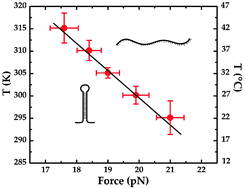Combining temperature and force to study folding of an RNA hairpin
Abstract
RNA folding in cells typically occurs at mesophilic temperatures. However, in vitro, RNA can be unfolded either by increasing temperature to values that are much higher than physiological, or by mechanically pulling structures apart at ambient temperature. To directly study RNA folding at physiological temperatures and to unify thermodynamics measured by melting and pulling, we developed temperature-controlled optical tweezers (thermal tweezers) that can be used to mechanically unfold single RNA molecules at mesophilic temperatures. Folding of a 20-base-pair tetraloop hairpin was studied under different ionic conditions and at temperatures ranging from 22 °C to 42 °C. At each temperature, single hairpin molecules were held at constant force, and their two-state folding equilibria were monitored. The change in free energy derived from these measurements was used to construct a phase diagram of RNA structure using force and temperature as variables. Furthermore, we derived ΔG0pN,T, the folding free energy at zero force and temperature T, by subtracting the stretching energy of unfolded RNA from the reversible mechanical work done to unfold the hairpin. ΔG0pN,T and its salt dependence agree reasonably well with the predictions by the nearest neighbor model. Under each ionic condition, ΔG0pN,T depended linearly on temperature, yielding ΔHexp and ΔSexp that also matched the predictions. The combination of force and temperature to study RNA folding is a step toward unifying thermodynamics measured by thermal melting and mechanical unfolding, and opens a new path for directly monitoring temperature induced RNA structural changes, as it occurs often in biology.


 Please wait while we load your content...
Please wait while we load your content...